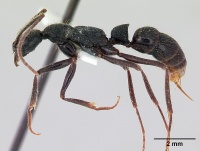Leptogenys gatu
| Leptogenys gatu | |
|---|---|

| |
| Scientific classification | |
| Kingdom: | Animalia |
| Phylum: | Arthropoda |
| Class: | Insecta |
| Order: | Hymenoptera |
| Family: | Formicidae |
| Subfamily: | Ponerinae |
| Tribe: | Ponerini |
| Genus: | Leptogenys |
| Species group: | unistimulosa |
| Species: | L. gatu |
| Binomial name | |
| Leptogenys gatu Lattke, 2011 | |
Some specimens were taken from leaf litter or pitfall traps. This species is called JTL-007 by Lattke & Longino (2009) in the Ants of Costa Rica website. Longino reports observing a column in Corcovado National Park in which one worker carried isopod prey above the head. (Lattke 2011)
Identification
Lattke (2011) - A member of the unistimulosa species group. Elongate head, wider anterad than posterad; hypostomal teeth prominent, curving anterad beneath head; mandible sharply bent at base, rest straight, widening apicad; petiolar node longer than wide in dorsal view with brief blunt posterior lobe.
Keys including this Species
Distribution
The range of Leptogenys gatu extends from Costa Rica to western Colombia.
Latitudinal Distribution Pattern
Latitudinal Range: 10.58333333° to 8.466666667°.
| North Temperate |
North Subtropical |
Tropical | South Subtropical |
South Temperate |
- Source: AntMaps
Distribution based on Regional Taxon Lists
Neotropical Region: Colombia, Costa Rica, Panama (type locality).
Distribution based on AntMaps
Distribution based on AntWeb specimens
Check data from AntWeb
Countries Occupied
| Number of countries occupied by this species based on AntWiki Regional Taxon Lists. In general, fewer countries occupied indicates a narrower range, while more countries indicates a more widespread species. |

|
Estimated Abundance
| Relative abundance based on number of AntMaps records per species (this species within the purple bar). Fewer records (to the left) indicates a less abundant/encountered species while more records (to the right) indicates more abundant/encountered species. |

|
Biology
|
Castes
Queens and males are unknown.
Nomenclature
The following information is derived from Barry Bolton's Online Catalogue of the Ants of the World.
- gatu. Leptogenys gatu Lattke, 2011: 215, fig. 70 (w.) PANAMA.
Unless otherwise noted the text for the remainder of this section is reported from the publication that includes the original description.
Description
Worker
Metrics, holotype (paratypes, n = 6): HL 1.65 (1.62–1.82); HW 1.45 (1.42–1.52); ML 1.15 (1.04– 1.28); EL 0.40 (0.37–0.44); SL 2.02 (1.82–2.29); PW 1.15 (1.11 – 1.28); WL 3.17 (2.97 – 3.37); PH 1.15 (1.15 – 1.28); PL 0.98 (0.84–1.04); DPW 0.71 (0.67–0.78) mm. CI 0.88 (0.83–0.90); MI 0.79 (0.74–0.84); OI 0.28 (0.26 – 0.30); SI 1.40 (1.29 – 1.58); LPI 1.17 (1.10 – 1.36); DPI 0.72 (0.65 – 0.84).
Head elongate in full-face view, wider anterad than posterad, laterad margin straight to weakly convex, forming continuous curvature with convex posterior margin, anterior clypeal margin with median lobe forming abrupt angle with lateral lobe; apex of median lobe with 8 or more setae. Eye length covers more than one-third lateral cephalic margin. Scape surpasses posterior cephalic border by over one-third its length; length of fourth antennal segment more than half the length of third antennal segment. Mandible mostly straight, sharply bent at base, weakly widening apicad, basal angle with or without a denticle. PF 4,4. Cephalic dorsum mostly rugulose punctuate, sculpture softening toward vertex; lateroventrally and ventrally smooth and shining; hypostomal tooth longer than greatest mandibular width, projecting anteroventrad, very prominent in full-face view.
Mesosoma with broadly convex pronotal margin in lateral view, mesonotum forms distinct convexity, propodeal margin forms weakly convex slope that descends to declivity, dorsal propodeal margin more than 2 × length of declivitous margin. Pronotal side longitudinally striate, discal area mostly smooth with shallow punctae; prosternum transversely striate, tending to smooth medially; mesopleuron with anterior strip of transverse striae, mesometapleura mostly transverse to obliquely striate-rugulose; lateral propodeal face transversely rugose. Mesosternum mostly smooth and shining; mesonotum mostly smooth; propodeal dorsum weakly striate to smooth; declivitous propodeal face transversely striate; spiracle elongate, almost slit-like.
Petiole in lateral view with convex to weakly convex anterior face that curves to posteriorly ascending dorsal margin that ends in blunt, overhanging lobe; posterior margin sinuous. Lateral face mostly with oblique striae, ventrally smooth; posterior face flattened, smooth and shining. Node elongate in dorsal view; gaster smooth and shining. Head, mesosoma, and petiole black; mandibles, legs, and gaster brown. Scape with sub-decumbent hairs and semi-erect pilosity; body with abundant semi-erect hairs.
Type Material
Holotype worker. Panama, Canal Zone, Punta de los Chivos, W side Gatun Lake, 3 km SW Gatún, 100 m, 3.–9. vii.1979, W.L. Brown. One worker deposited in Los Angeles County Museum of Natural History, the top specimen of two point-mounted ants on a single pin. LACM Accession 142584. – Paratypes. Seven workers with the same data as the holotype. One worker is the bottom specimen on the pin that bears the holotype, the six other workers are deposited in Museum of Comparative Zoology.
Etymology
The species name alludes to the type locality, which is located in the vicinity of Lake Gatun.
References
References based on Global Ant Biodiversity Informatics
- Lattke J. E. 2011. Revision of the New World species of the genus Leptogenys Roger (Insecta: Hymenoptera: Formicidae: Ponerinae). Arthropod Systematics and Phylogeny 69: 127-264

